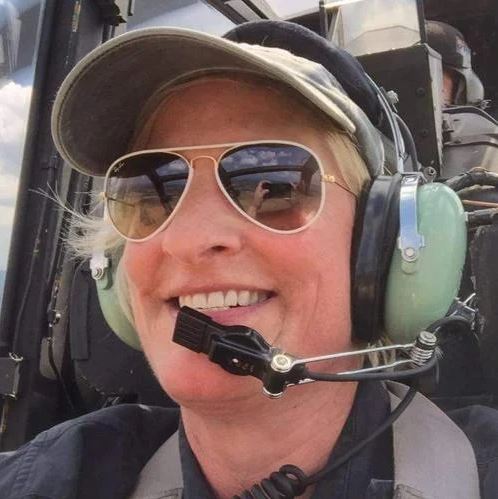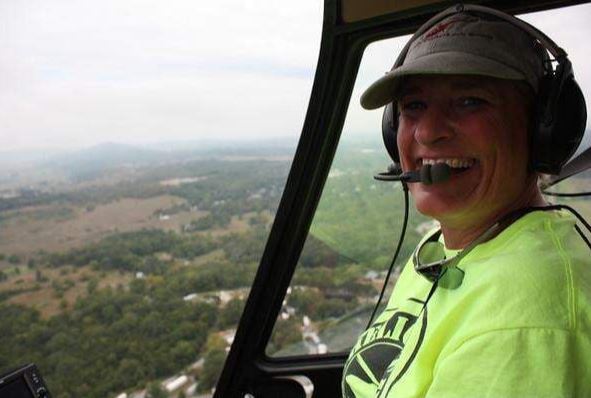
For more than two decades, Angie Griffin, 61, lived another life — a full and accomplished life — as an experiential counselor, a corporate team builder, a charter school guidance counselor, and a university administrator before her career took an unexpected and dramatic turn.
Today, she is known as “Grangie” by her three grandchildren, but this woman is hardly the typical grandmother, if indeed such a thing even exists. A member of the Female Helicopter Pilots Association, known as The Whirly Girls, Griffin is the newest member of the faculty in the Texas A&M University-Central Texas Aviation Program.
Together with Carson Pearce, associate lecturer, and coordinator, the two of them are shepherding more than 100 undergraduate students through to completion as the program grows by leaps and bounds.

She understands, she says, the powerful lure of the skies, the intellectual heft required to master a career that sometimes both relies on and routinely defies the laws of physics, and the power of the unseen and fateful forces that ushered her to this point in her life.
“Even with a former career in counseling, I have to be very practical when it comes to flight,” she said stoically. Her face, however, tells an entirely different truth.
When she describes how she entered aviation, her face becomes a silent choreography of expressions as pale blonde eyebrows rise and fall excitedly in cadence with her words, and her effervescent green eyes and inextinguishable 500-watt smile make it impossible not to feel the reverberations of her enthusiasm bouncing around the room in joyful abandon.
Put another way, the truth is as obvious as it is simple: Angie Griffin loves helicopters. But, oddly, fate had to intervene before she allowed herself to recognize that simple fact and act on it, slowly at first, and then at a land speed record pace that culminated in a move to Central Texas.
Two decades into her career, she admits, she was proud of all she had accomplished, but as her 40th birthday approached, she began to wonder if her life might be destined for something different. At that time, it was not a ‘bolt out of the blue’ moment. It was more subtle than that. It was the dawning of an awareness that happened gradually over time. And it did not shout; it whispered. At first.
“When I was working as a therapist, I had a client who was very young,” she began, making a pea-sized measured space between her thumb and forefinger.
“He was maybe six or seven years old, and one day, for no particular reason, he gave me a teeny, tiny helicopter that he had made.”
It was barely bigger than a corner of a postage stamp, she explained, and apropos of nothing, he hadn’t just been inspired to give it to her, he made it himself from nothing more than a paper clip and the small, round eraser that sits at the top of a pencil.
She wasn’t sure why, back then, but she saved it. She hadn’t yet recognized her love for helicopters – or, for that matter, her love for flying – and she had never mentioned it to her client, but this sweet fateful token would not be the last of the signs that would direct her future.
A few years later, while she was working at the University of Houston’s downtown campus, she had yet to shed the restlessness. No, it was still with her as it had been before. A constant whispering presence in her mind that suggested that something else was coming. Something new. Something life changing.
She told her circle of friends, and they teased her, suggesting that she was experiencing the symptoms of mid-life crisis. Some of them suggested she buy a new convertible and get over it, she laughed. What she was experiencing would not be quenched by a mere landbound vehicle. Her escape and her answer would come with a main and tail rotor, a cockpit, and skids.
What she had told no one, she said, was that her world had become a gray place, lacking even the energy to muster colors. It was secure, but monotonous. She hadn’t stopped loving her life, but she knew that it was missing something.
In an effort to restore herself, she invited her parents to join her on an adventure trip. She had always loved that part of her job as an experiential therapist. Get out into the world, she thought. See what it gives back.
It was there in Juno, Alaska, on Mendenhall Glacier. She had scheduled a dogsled run identical to the storied Iditarod Race.
“We took a helicopter ride up to the glacier,” she said, her voice subtly softening as if she might be sharing a secret. Only this was no longer a secret. It was, instead, maybe the first time she had ever put the magic of that moment into words and the impact of that moment had finally been recognized for just how important it had proved to be.
“The minute that helicopter left the ground, the whole world literally burst into color again,” she began. “It was like the past years and the routine I had been living were swept away, and I just knew inmy soul what was happening,” she said. “I knew I was meant to learn to fly.”
Within four months, she had left her job and enrolled in flight school at the Houston Southwest Airport. She had been a savvy saver and investor throughout her career. And she knew she was blessed to be able to fund her dream.
But her dream was far from the carefree, devil-may-care, silk scarf afloat in the open air of a vintage plane. Nope. At the end of her first lesson in a Cessna two-seater, Angie stood on the tarmac in the Houston heat, soaked from head to toe, her khaki pants, boots, and cotton shirt drenched with her own sweat – every inch of hercould have been wrung out like an oversoaked sponge.She had experienced her first flight in the 90+ degrees only intensified by an enclosed cockpit.
One month later, she completed her training, earning her license as a private pilot. Once again, she said, she had to adapt to a learning curve that required her to set aside all her previous training as an educator and counselor.
In the cockpit of a helicopter, a student pilot needs spatial awareness, a basic understanding of physics, and a realistic sense of risk management. And, of course, a patient instructor.
“The first time my teacher asked me to hover the aircraft, I wobbled that helo all over the place,” she laughed. “There was nothing pretty about that first try. But as a student, you learn to let it become a part of you, and in turn, you become part of it. It’s getting to that point that takes patience and perspective and prayer.”
And that, as they say, is how Griffin found herself in Central Texas. She had earned her FAA licenses for both helicopters and airplanes, become part of the flying culture, and opened, and subsequently closed, an aviation business.
Looking back, Griffin acknowledges that she was — and still is — quite lucky. While she certainly didn’t set any records recognizing her true calling, she hadn’t recognized it, either. When she was a child, she said, whenever she had a book report or essay to write, she always chose Amelia Earhart.
So, what if she hadn’t pursued flight as a career, she asked. We all follow the path we believe is the one that is available to us. She didn’t regret being a counselor; she just wished she hadn’t taken so long to recognize her passion for flying.
But she isn’t ready to stop there. In fact, one of the reasons why she was drawn to the aviation program at A&M-Central Texas was the ability to combine her love for education with her passion for flying.
Translated into action, that means her days are consumed with teaching the more than 100 aviation students now in the program with, and under the supervision of program coordinator, Carson Pearce.
“He is such a valuable part of our program,” she said. “His expertise and his vision for the program has brought so many students to us and served his profession when they have needed us the most.”
The A&M-Central Texas program, she explains, accepts the FAA credentials their students have already earned — meaning that it is possible for entering students to convert those credentials into as many as 42 hours of credit towards their degree.
“It’s a win-win-win,” said Carson Pearce, associate lecturer, and aviation program coordinator. “Not only does it make all the sense in the world to convert their training into degree credits, doing that makes our program the fastest and least expensive in the country. The training is excellent, completely online, and puts them on track for a mid-six figure salary. We call that success.”
As a woman in aviation — still a predominantly male field — Angie has her eyes on the sky, even while she remains firmly anchored in the classroom. And, in characteristic fashion, she has a plan. She wants to develop a STEM initiative focused on recruiting more female students into the program.
There are almost 65,000 student pilots in training, she explained. And the dropout rate is a staggering 60-70%. A mere 16,000 are commercial or ATP pilots — and a scant two out of a thousand are female helicopter pilots. But, if more women and girls knew of the potential of an aviation career, they just might take the path she waited almost forty years to take.
“I’m a fairly practical person, and I don’t often feel the need to over-romanticize things,” she said, as a hint of blush rose in her cheeks. “But the luckiest people in the world are those who are in love with their job. Our pilots all share that, and so do I. But even as much as I love to fly, I love this just as much, if not a teensy bit more.”
